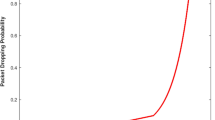Abstract
The random early detection active queue management (AQM) scheme uses the average queue size to calculate the dropping probability in terms of minimum and maximum thresholds. The effect of heavy load enhances the frequency of crossing the maximum threshold value resulting in frequent dropping of the packets. An adaptive queue management with random dropping algorithm is proposed which incorporates information not just about the average queue size but also the rate of change of the same. Introducing an adaptively changing threshold level that falls in between lower and upper thresholds, our algorithm demonstrates that these additional features significantly improve the system performance in terms of throughput, average queue size, utilization and queuing delay in relation to the existing AQM algorithms.



















Similar content being viewed by others
References
Floyd, S., & Jacobson, V. (1993). Random early detection gateways for congestion avoidance. IEEE/ACM Transactions on Networking, 1(4), 397–413.
Athuraliya, S., Li, V. H., Low, S. H., & Elissa, Q. Y. (2002). REM: Active queue management. IEEE Network, 15(3), 48–53.
Feng, W., Shin, K. G., Kandlur, D. D., & Saha, D. (2002). The BLUE active queue management algorithms. IEEE/ACM Transactions on Networking, 10(4), 513–528.
Meckenney, P. E. (1990). Stochastic fair queuing. In Proceedings of IEEE INFOCOM (pp. 733–740, Vol. 2).
Floyd, S., Gummadi, R., & Shenker, S. (2001). Adaptive RED: An algorithm for increasing the robustness of RED’s active queue management. Berkeley, CA. http://www.icir.org/floyd/papers.html.
May, M., Bolot, J., Diot, C., & Lyles, B. (1999). Reasons not to deploy RED. In Proceedings of IWQoS (pp. 260–262)
Wang, H., & Shin, K.G. (1999). Refined design of random early detection gateways. In Proceedings of IEEE GLOBECOM (pp. 769–775).
Feng, G., Agarwal, A. K., Jayaraman, A., & Siew, C. K. (2004). Modified RED gateways under bursty traffic. IEEE Communications Letters, 8(5), 323–325.
Low, S. H., Paganini, F., Wang, J., & Doyle, J. C. (2003). Linear stability of TCP/RED and a scalable control. Computer Networks, 43(5), 633–647.
Tan, L., Zhang, W., Peng, G., & Chen, G. (2006). Stability of TCP/RED systems in AQM routers. IEEE Transactions on Automatic Control, 51(8), 1393–1398.
Woo, S., & Kim, K. (2010). Tight upper bound for stability of TCP/RED systems in AQM routers. IEEE Communications Letters, 14(7), 682–684.
Bhatnagar, S., & Patro, R. K. (2009). A proof of convergence of the B-RED and P-RED algorithms for random early detection. IEEE Communications Letters, 13(10), 809–811.
Adams, R. (2013). Active queue management: a survey. IEEE Communations Surveys & Tutorials, 15(3), 1425–1476.
Feng, C. W. , Huang, L. F., Xu, C., & Chang, Y. C. (2015). Congestion control scheme performance analysis based on nonlinear RED, Journal of IEEE Systems, PP(99), (1–8). [Early Access Article].
Hollot, C.V., Misra, V., Towsley, D., & Gong, W. (2001). On designing improved controllers for AQM routers supporting TCP flows. In Proceedings of IEEE INFOCOM (pp. 1726–1734).
Hollot, C. V., Misra, V., Towsley, D., & Gong, W. (2002). Analysis and design of controllers for AQM routers supporting TCP flows. IEEE Transactions on Automatic Control, 47(6), 945–959.
Wu, Y., Min, G., & Yang, L. T. (2013). A network and device aware QoS approach for cloud-based mobile streaming. IEEE Transactions on Multimedia, 15(4), 747–757.
Wang, J., Rong, L., & Liu, Y. (2008). A robust proportional controller for AQM based on optimized second-order system model. Computer Communications, 31(10), 2468–2477.
Chavan, K., Kumar, R. G., Belur, M. N., & Karandikar, A. (2011). Robust active queue management for wireless neyworks. EEE Transactions on Control Systems Technology, 19(6), 1630–1638.
Tse, D., & Viswanath, P. (2005). Fundamentals of wireless communication. Cambridge: Cambridge University Press.
Wu, Y., Min, G., & Yang, L. T. (2013). Performance analysis of hybrid wireless networks under bursty and correlated traffic. EEE Transactions on Vehicular Technology, 62(1), 449–454.
Author information
Authors and Affiliations
Corresponding author
Rights and permissions
About this article
Cite this article
Karmeshu, Patel, S. & Bhatnagar, S. Adaptive mean queue size and its rate of change: queue management with random dropping. Telecommun Syst 65, 281–295 (2017). https://doi.org/10.1007/s11235-016-0229-4
Published:
Issue Date:
DOI: https://doi.org/10.1007/s11235-016-0229-4




